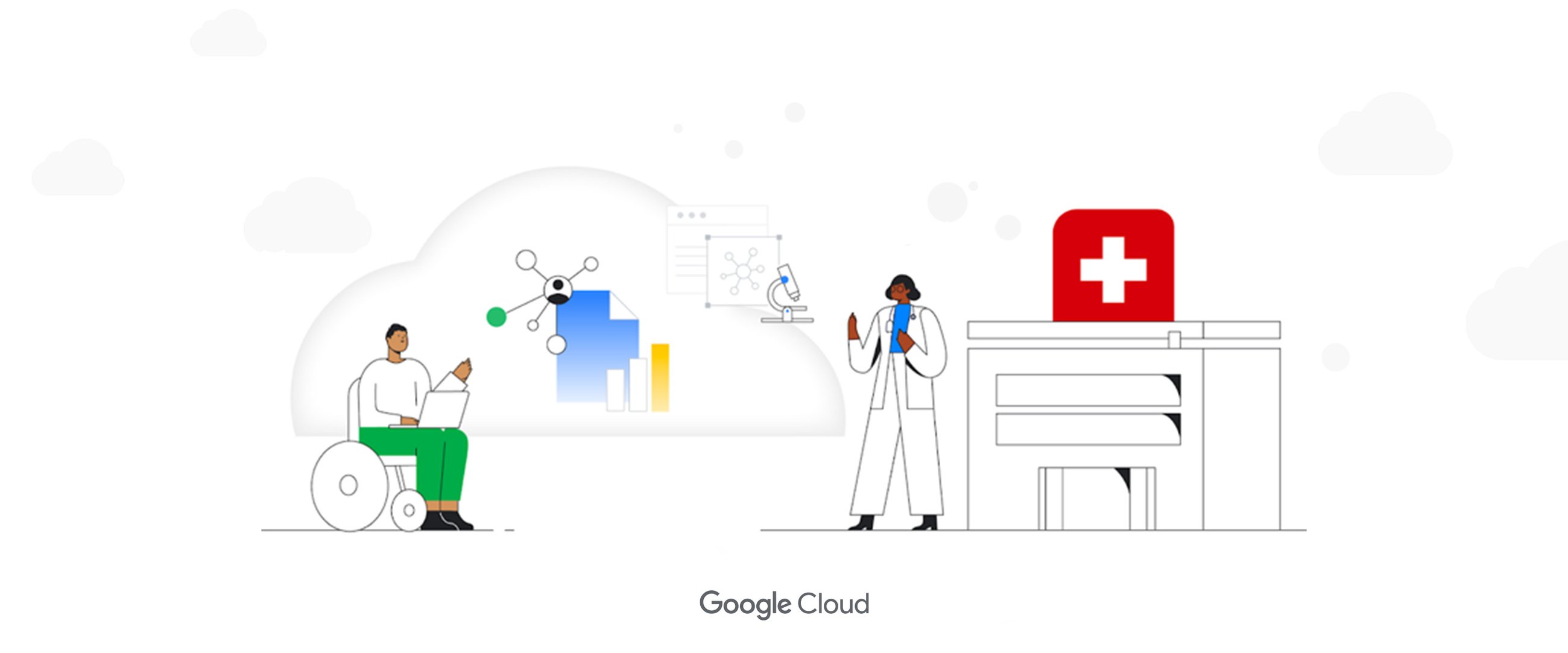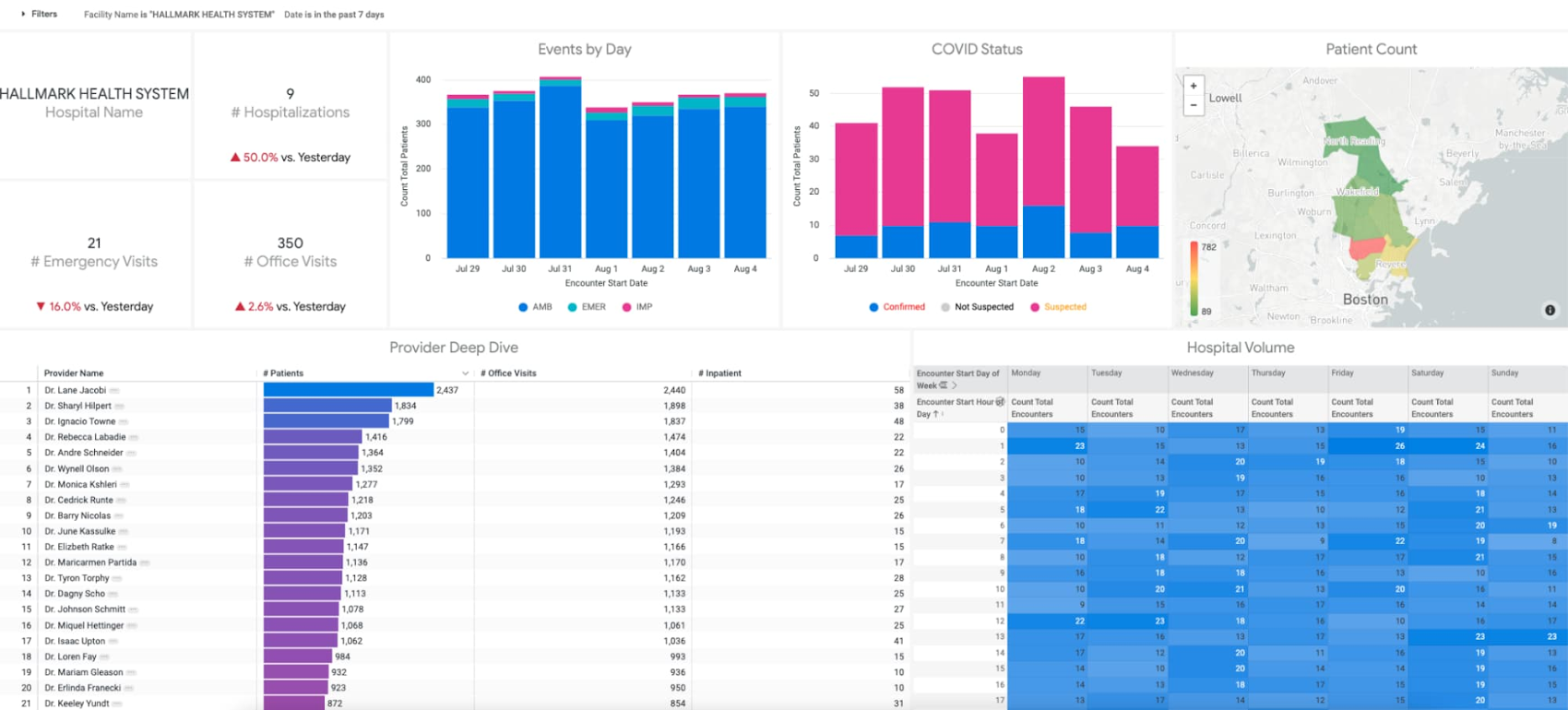Google Cloud improves Healthcare Interoperability on FHIR

Aaron Wilkowitz
Customer Engineer, Looker, Healthcare & Life Sciences
Try Google Cloud
Start building on Google Cloud with $300 in free credits and 20+ always free products.
Free trialThe Importance of Interoperability
In 2020 hospital systems were scrambling to prepare for COVID-19. Not just the clinicians preparing for a possible influx of patients, but also the infrastructure & analytics teams trying to navigate a maze of Electronic Health Records (EHR) systems. By default these EHRs are not interoperable, or able to speak to one another, so answering a relatively simple question “how many COVID-19 patients are in all of my hospitals?” can require many separate investigations.
Typically, the more complex a dataset is, the more difficult it is to build interoperable systems around it. Clinical data is extremely complex (a patient has many diagnoses, procedures, visits, providers, prescriptions, etc.), and EHR vendors built and managed their own proprietary data models to handle those data challenges. This has made it much more difficult for hospitals to track a patient’s performance when they switch hospitals (even within the same hospital system) and especially difficult for multiple hospitals systems to coordinate on care for nationwide epidemics (e.g. COVID-19, opioid abuse), which makes care less effective for patients & more expensive for hospitals.
A Big Leap Forward in Interoperability
Building an interoperable system requires:
(1) A common data schema
(2) A mechanism for hospitals to bring their messy real-world data into that common data schema
(3) A mechanism for asking questions against that common data schema
In 2011 a common FHIR (Fast Healthcare Interoperability Resources) Data Model & API Standard provided an answer to (1): a single data schema for the industry to speak the same data language. In the past 18 months, Google Cloud has deployed several technologies to unlock the power of FHIR and solve for (2) and (3):
Google Cloud’s Healthcare Data Engine (HDE) produces FHIR records from streaming clinical data (either HL7v2 messages out of EHR systems or legacy formats from EDWs). This technology then enables data use for other applications & analytics in Google BigQuery (BQ)
Google Cloud’s Looker enables anyone in a healthcare organization to ask any question against the complex FHIR schema in Google BigQuery
Now a hospital system can quickly ask & answer a question against records from several EHR systems at once.


Applications Seen So Far
In less than 18 months, GCP has seen dozens of applications for HDE, BigQuery, and Looker working together to improve clinical outcomes. A few applications that have been particularly successful so far have answered questions like:
How many readmissions will a hospital expect in 30 days?
How long will each inpatient patient stay in a hospital?
How can a hospital better track misuse & operational challenges in prescribing opioid drugs to my patients?
How can a hospital quickly identify anomalies in patients’ vital signs across my hospital system?
How can a hospital identify & minimize hospital-associated infections (e.g. CLABSI) in my hospital?
How can a hospital prepare for COVID-19 cases across a hospital system? And leverage what-if planning to prepare for the worst?
These use cases represent just the tip of the iceberg of possibilities for improving day-to-day operations for clinicians & hospitals.
Solving Major Challenges in Interoperability
Latency: Hospitals often rely on stale weekly reports for analytics; receiving analytics in near real-time enables hospitals to identify problems and make changes much more quickly. COVID-19 in particular highlighted the need for faster turnaround on analytics. GCP’s Healthcare Data Engine handles streaming clinical data in the form of HL7 messages. As soon as messages arrive, they are transformed into FHIR and sent over to the BigQuery database to be queried. There is minimal latency, and users are querying near real-time data.
Scale: The scale and scope of hospital data is rapidly increasing as hospitals track more clinical events and as hospitals consolidate into larger systems. Hospitals are adopting cloud-based systems that autonomously scale to handle the intensive computation necessary to take in millions of clinical records with growing hospital system datasets. GCP’s serverless, managed cloud is meeting these needs for many hospital systems today.
Manage Multiple Clinical Definitions: Today hospitals struggle to manage definitions of complex clinical KPIs. For example, hospitals had many different definitions for a positive COVID-19 result (based on a frequently changing set of lab results and symptoms), which creates inconsistencies in analytics. Additionally, those definitions are often buried in scripts that are hard to adjust and change. HDE has developed capabilities that consistently transform HL7 messages into the FHIR store in a scalable fashion. Looker then provides a single source of truth in an object-oriented, version-controlled semantic layer to define clinical KPIs and quickly update them.
Represent FHIR Relationally: FHIR was originally intended for XML storage to maximize schema flexibility. However, this format is usually very difficult for analytical queries, which perform better with relational datasets. In particular, FHIR has rows of data buried (or “nested”) within a single record (e.g. a single patient record has many key-value pairs of diagnoses) that make FHIR difficult to ask questions against. BigQuery is an analytical database that combines the analytical power of OLAP databases with the flexibility of a No-SQL data schema by natively storing FHIR data in this “nested” structure and querying against it.
Query Quickly against FHIR: Writing unnested queries to a schema as complex as FHIR can be challenging. GCP’s Looker solution writes “nested” queries natively to BigQuery, making it much simpler to ask & answer new questions. This also prevents the “cube / extract” problem so common in healthcare, where hospitals are forced to build, manage, and maintain hundreds of simplified data cubes to answer their questions.
Predict Clinical Outcomes: Predictive modelling with AI/ML workflows has matured significantly. Hospitals increasingly rely on AI/ML to guide patients & providers towards better outcomes. For example, predicting patient, staffing, and ventilator volumes 30 days in advance across a hospital system can minimize disruptions to care. Leveraging FHIR on GCP enables GCP’s full suite of managed AI/ML tools - in particular BQML (BigQuery Machine Learning) and AutoML.
Ensure 24/7 Data Availability: COVID-19 exposed the vulnerabilities of relying on staffed on-premise data centers; GCP’s cloud infrastructure ensures availability and security of all clinical data.
Protect Patient Data: Interoperability blends the need for private patient data to stay private while allowing data to be shared across hospitals. Researchers in particular often require granular security rules to access clinical data. Today hospitals often use an extract-based approach that requires many copies of the data outside of the database, a potential security flaw. GCP’s approach ensures that hospitals can query the data where it resides - in a secure data warehouse. Additionally, every component of GCP’s FHIR solution (HDE, BQ, Looker) can be configured to be HIPAA-compliant and includes row-level, column-level, and field-level security that can be set by users to ensure cell-level control over PHI data. GCP’s Cloud Loss Prevention API also anonymizes data automatically.
Speed to Insights: The complexity of data can lead to long windows to build analytics pipelines, leading to delays in healthcare improvements. GCP’s FHIR solution is relatively low-effort to implement. HDE can be set up against streaming HL7 messages in a few days and weeks, not months and years. Looker has a pre-built FHIR Block (coming to the Looker Blocks Directory and Marketplace soon) that can be installed & configured for a hospital’s particular data needs.
Share Insights Broadly: Interoperability requires not just being able to query across multiple systems, but also to share those insights across multiple platforms. GCP’s FHIR solution allows hospital systems to analyze governed results on FHIR, then send them anywhere: to dashboards in Looker, other BI tools, embedded applications, mobile apps, etc. For example, the National Response Portal represents the promise of hospitals and other organizations sharing aggregated healthcare data for nationwide insights around COVID-19.
For a technical review of GCP’s Healthcare Data Engine against Azure’s & AWS’ solutions, see here and here.
The New Frontier
This new healthcare data stack at Google Cloud represents a significant step forward towards interoperability in healthcare. When hospitals can communicate more easily with each other and when complex analytics are easier to conduct, everyone wins. Patients have better healthcare outcomes, and hospitals can provide care more efficiently.
Google Cloud is committed to continue partnering with the largest hospital systems in the country to solve the most challenging problems in healthcare. Patients’ lives depend on it.




